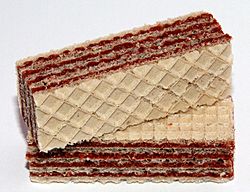Neapolitan wafer facts for kids

Neapolitan wafers stacked, showing five layers of wafer and four of hazelnut-chocolate cream
|
|
| Type | Wafer |
|---|---|
| Place of origin | Austria |
| Created by | Manner (confectionery) |
| Main ingredients | Hazelnuts |
Neapolitan wafers are yummy wafer and chocolate-cream biscuits. Some people also call them gaufrettes. An Austrian company called Manner first made these tasty treats in 1898.
These wafers get their special flavor from hazelnuts. These hazelnuts come all the way from the area of Naples, Italy. Each biscuit has five thin wafer layers and four creamy layers of hazelnut-chocolate filling. They are about 49 millimetres (1.9 in) long, 17 millimetres (0.67 in) wide, and 17 millimetres (0.67 in) tall. The way they are made has stayed almost the same for over 100 years!
Contents
The Story of Neapolitan Wafers
How They Were Created
The Manner company in Austria was the first to create Neapolitan wafers. They started making them in 1898. The idea was to make a simple, delicious snack. They used hazelnuts from Naples, which gave the wafers their unique name.
Keeping the Recipe the Same
Even today, the basic recipe for Neapolitan wafers is still the same. This means that the wafers you eat now taste very similar to the ones made over a century ago. Manner still sells these biscuits in packs of ten. Many other companies have tried to copy the idea. Often, these copies are covered in an extra layer of chocolate.
Wafers Around the World
Popularity in Eastern Europe
Neapolitan wafers became very popular in the USSR (the Soviet Union) and other countries in Eastern Europe. This was because they were cheap to make. They also stayed fresh for a long time and were easy to produce.
Even now, these wafers are a favorite snack in Russia and other countries that used to be part of the Soviet Union. They are especially popular with older people.
See also
 In Spanish: Napolitana (wafer) para niños
In Spanish: Napolitana (wafer) para niños

